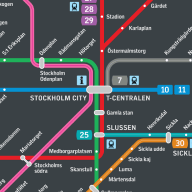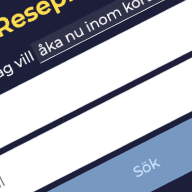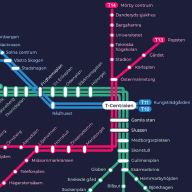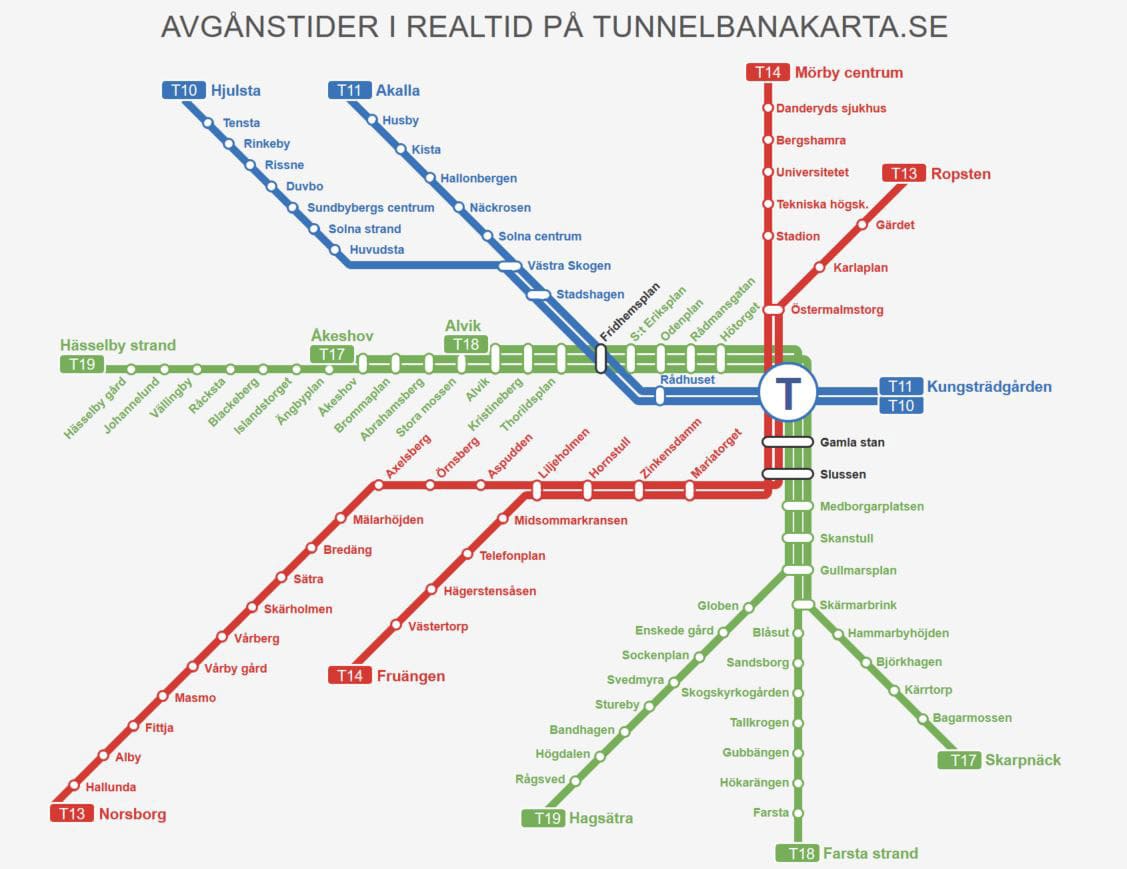Ad | Tunnelbana karta
- T10Hjulsta
- T10
- T11Akalla
- T11Kungsträdgården
- T14Mörby centrum
- T13Ropsten
- T14Fruängen
- T13Norsborg
Metro map for Stockholm
Metro map for Stockholm (Tunnelbana karta). A metro train line map with seven metro lines in three colors. Stockholm’s metro map consists of blue, red and green lines. The blue line is served by trains with the numbers 10/11, red by 13/14, and the green by 17/18/19. There is also an interactive MRT map of Singapore available if you are traveling to Singapore. Or for Washington DC, you can go to the DC Metro Map. You can also check out the tube map of the world famous London Underground, a.k.a The Tube.
Metro Stockholm
2016 was the starting point for the expansion of the Stockholm metro. This project is expected to be fully expanded by 2025. It is mostly an extension of blue line that will extend from Barkarby station all the way to the Nacka Forum.
The new stations along the blue line will be Barkarby station, Barkarbystaden, Arenastaden, Hagastaden, Sofia, Hammarbykanal, Sickla, Saltsjö-Järla and Nacka Forum.
Commuter train
Map for the commuter trains in Stockholm. To know the difference between the metro and commuter trains here is a video of a commuter train. The commuter trains go between Swedens 4th largest city Uppsala located north of the capital and all the way down south to Södertälje and Gnesta.
More about the metro in Stockholm
Stockholm metro is a metro in Stockholm City, Sweden. The first track was opened in 1950, and today the subway system has about 100 stations and more will be added within a couple of years. 47 of these are underground and 53 are above ground. There are three colored lines on the line map. However, these need to form seven actual lines (with different start and end stations). Lines number 17, 18 and 19 (belonging to the green ), 13 and 14 (red ) and 10 and 11 (blue main line) all these lines pass T-Centralen which makes it a very central metro system. In addition to the T-station there is only one other station where the lines are crossed, and it is Fridhemsplan’s metro station.
The metro is like London’s metro and Paris subway but unlike the U-Bahn and S-Bahn in Berlin equipped with ticket gates. No ticket check is done on board the train as it is done on a reular train with conductors, but it is quite common for inspectors to show up on the train. Individual tickets must be purchased in advance (usually in privately owned smaller stores and kiosks) or at ticket machines available at all metro stations and at several metro or bus stations. Passengers can also buy tickets in the stall at the gates of the subway.
2013, Stockholm’s subway had 328 million passengers, corresponding to approximately 898,630 riders per day.
The 105.7-kilometer subway is owned by Stockholm County Council through the company Storstockholms Lokaltrafik (SL). The operations are contracted to MTR Corporation.
Stockholm’s metro has been called the world’s longest art gallery, with more than 90 of the network’s 100 stations decorated with sculptures, mosaics, paintings, installations, engravings and relics of over 150 different artists.
Metro history
The decision to build a subway was made in 1941. Some subway lines were built as subways but were run by trams. Among other things, Kristineberg, Slussen-Blåsut (including the oldest tunnel Slussen-Skanstull from 1933) and Telefonplan-Hägerstensåsen. The first part of the subway was opened on October 1, 1950, which departed Slussen to Hökarängen, at that time, you went completely from tram traffic to metro. In 1951 a second line was opened from Slussen to Stureby. In 1952, one also started driving from Hötorget to the western suburbs. In 1957, the two parts were connected via the Central Station (at the T-Central) and the Old Town (at Old Town’s metro station), and then formed the green line. During the period 1950-1960 the green line was extended bit by bit.
The red line was opened in 1964, which went from T-Centralen via Liljeholmen to Fruängen and Örnsberg. Even that line was extended bit by piece until 1978. The third and final line of the line system, the blue line, was opened in 1975, with two lines that went north-west from the center. As construction requirements have become more stringent in recent years, hence the stations were built on the blue line with much closer distances. The latest addition to the entire network is Skarpnäck station, which was opened in 1994.
About the metro stations
DThere are 100 stations in use in the Stockholm metro (of which 47% are underground). A station, Kymlinge, was built but never taken into use. A station has been disconnected and demolished. The Bagarmossen old surface station was demolished and replaced with a new subway station, instead, this before Metron to Skarpnäck metro station.
Stockholm metro is well known for its embellishment of the stations; It has been called the longest art gallery in the world. Several of the stations (especially on the blue line) are left with the bedrock exposed, raw and unfinished, or as part of decorations. At Rissne, an informative wall about the history of the earth’s civilizations runs along both sides of the platform.
Metro lines
The following information relates to the current network. The terms ”blue line”, etc., have been used only since the late 1970s, and officially only since the 1990s. They derive from the fact that the ”blue line” tended to drive newer trains making painted blue, while the ”green line” had older layers in the original green life tree. There was never any red-painted layer, but, but red (or originally orange) was chosen to distinguish this line from the other two network on-road maps.
The green line (official Tunnelbana 1, or ”Metro one”) has 3 row numbers and 49 stations: 12 underground (nine concrete, three rock) and 37 above ground stations. The track is 41,256 meters long. It opened Oct. 1, 1950 (between Slussen and Hökarängen stations). It is used by 451,000 passengers per working day or 146 million per year (2005). The red line (Tunnelbana 2) has 2 line numbers and 36 stations: 20 underground (four concrete, 16 rock) and 15 above ground stations. The course is 41,238 meters long. It opened April 5, 1964. It is used by 394,000 passengers per working day or 128 million per year (2005).
The blue line (Tunnelbana 3) has 2 line numbers and 20 stations: 19 underground (all rock) and an elevated station. The course is 25,516 meters long. It opened August 31, 1975. It is used by 171,000 passengers per working day or 55 million per year (2005). Trains run from 5:00 to 01:00, with extended all night service on Fridays and Saturdays. All lines have trains every 10 minutes during daytime, reduced to 15 minutes in early mornings and late evenings, and every 30 minutes during nights. Additional trains during rush hour provide a train every 5-6 minutes at most stations, with 2-3 minutes between trains on the central parts of the network.
The metro contains four traffic (T-Central, Slussen, Gamla Stan and Fridhemsplan) and lacks any circular or partial circular line (although Stockholm has a semi-circular tram line, Tvär). An overwhelming majority of subway stations are located in suburbs, but the network is centered at the T-Central where all trains throughout the network pass.
In the past, there have been additional line numbers used for trains run on part of a line or only during rush hours. For example, row number 23 was used for a top relief train for line 13 which was run between Sätra and Östermalmstorg in the 1970s between Norsborg and Mörby Centrum.
Infrastructure and safety
The Stockholm subway is electrically powered by a third rail with a nominal operating voltage of 650 V DC on lines 13, 14, 17, 18 and 19; And 750 V DC on lines 10 and 11.
The maximum speed is 80 kilometers per hour on the red and blue lines, 70 kilometers per hour on the green line (50 kilometers per hour on the platforms). Maximum acceleration and braking is 0.8 m / s2. The reason for the lower speed limit on the green line is due to narrower curves than on the other lines, since the green line was built of cliff and covers the streets of the inner city, while the other lines are drilled to greater depth. There are two security systems in the subway: the old system manufactured by Union Switch and Signal used on the red and blue lines and a newer autopilot system used in the green line and manufactured by Siemens.
The maximum speed is 80 kilometers per hour on the red and blue lines, 70 kilometers per hour on the green line (50 kilometers per hour on the platforms). Maximum acceleration and braking is 0.8 m / s2. The reason for the lower speed limit on the green line is due to narrower curves than on the other lines, because the green line was built by cliff and covers the streets of the inner city while the other lines are drilled at greater depths. There are two security systems in the subway: the old system manufactured by Union Switch and Signal used on the red and blue lines and a newer autopilot system used in the green line and manufactured by Siemens.
Another option is automatic train operation, which helps the driver by driving the train automatically. However, the driver still drives the door controls and allows the train to start. As of 2006, ATO is only available on the green line, where a new signal was installed in late 1990. This signal system, along with C20 rolling layers, allows the use of ATO. However, the red line signal system is to be replaced by communications-based train control made by Ansaldo STS, which will come into operation in 2014.
The future
In 2013, it was announced that an agreement had been reached on the future of several extensions, with construction expected to start in 2016 and commercial traffic on the first sections scheduled to start in 2020.
Extension of the blue line south from Kungsträdgården. There will be a new station in Sofia on Södermalm, after which the line divides with a branch continuing to Nacka (with three new stations) and the other to new underground platforms at Gullmarsplan, after which it will take over the current green line branch to Hagsätra. This allows higher frequencies on the green line to branch to Farsta Strand and Skarpnäck, which is currently limited by the fact that three branches pass the bottleneck at the T-Central.
Extension of the blue line northwest from Akalla to Barkarby railway station via a new station. The construction of a new fourth subway line, initially consisting of a short three-station line north from Odenplan via the new development on Hagastaden and ending in Arenastaden. This is planned for a possible extension to Danderyd and Täby in the northeast, exchange with the existing red line to Mörby center.

 arrow_circle_up
arrow_circle_up arrow_circle_up
arrow_circle_up arrow_circle_up
arrow_circle_up Forecast for Stockholm
Forecast for Stockholm 